Discuss all things Model T related.
Forum rules
If you need help logging in, or have question about how something works, use the Support forum located here
Support Forum
Complete set of Forum Rules Forum Rules
-
Topic author
vping
- Posts: 251
- Joined: Tue Sep 29, 2020 8:01 pm
- First Name: Vincent
- Last Name: Pina
- * REQUIRED* Type and Year of Model Ts owned: 1925 Tudor Sedan
- Location: Farmingdale
Post
by vping » Sun Feb 04, 2024 8:07 pm
Not me, my starter

So other than the gas tank woes, I have a new fully charged battery and spark at the plugs. Issue is the starter is really, really slow as in 1 rotation every 2 seconds.
I can easily spin the motor with the hand crank.
I'm assuming it's not in gear because it's not lurching forward.
Could it be the starter needs to come out and be re greased or something because it's been sitting for course to 25 years?
What else could it be?
-
Norman Kling
- Posts: 4692
- Joined: Tue Jan 08, 2019 1:39 pm
- First Name: Norman
- Last Name: Kling
- Location: Alpine California
Post
by Norman Kling » Sun Feb 04, 2024 8:20 pm
Do you know whether the car used a 12 volt battery when it was last in use? Starters can be rewound to use 12 volts. That would slow the starter if you are using 6 volts. Another thing to check would be the battery cable. It must be a heavier cable for 6 volts. You can get the correct cable from our suppliers. Others on the forum would know what gauge the battery cable should be. Other than that, I would suggest you take off the starter, remove the bendix spring and gear first then remove the starter. be very careful when you remove the cable because the terminal can easily be torn off inside the starter. Check for easy rotation of the shaft and clean up the comutator and brushes. Replace parts as necessary
Norm
-
Topic author
vping
- Posts: 251
- Joined: Tue Sep 29, 2020 8:01 pm
- First Name: Vincent
- Last Name: Pina
- * REQUIRED* Type and Year of Model Ts owned: 1925 Tudor Sedan
- Location: Farmingdale
Post
by vping » Sun Feb 04, 2024 8:26 pm
6v for sure. The battery I removed was replaced with the same make and model. I cleaned the terminals on the starter and starter switch as well as cleaned the cable ends. The cable is quite hefty.
-
NY John T
- Posts: 443
- Joined: Wed Nov 25, 2020 12:45 pm
- First Name: John
- Last Name: Killelea
- * REQUIRED* Type and Year of Model Ts owned: 1926 Touring, 1927 Tudor, 1925 Touring
- Location: Northport NY
- Board Member Since: 2020
Post
by NY John T » Sun Feb 04, 2024 8:54 pm
If the starter switch gets hot, that could be the problem. My older repro switch was burnt and corroded inside and got hot to the touch. Some repros are junk. Check every electric and ground spot so you have clean metal to metal connections, including mounting points. Lastly remove starter, correctly, and clean everything. Check brushes and armature. 6 volt is a good system when everything is clean.
-
havnfun
- Posts: 478
- Joined: Sun Jan 06, 2019 11:27 am
- First Name: Joe
- Last Name: Kowalczyk
- * REQUIRED* Type and Year of Model Ts owned: 1918 Speedster, 1913 Runabout, 1923 Roadster, 1912 Mother-in-law roadster
- Location: Kuna, Idaho
- Board Member Since: 2017
Post
by havnfun » Sun Feb 04, 2024 9:30 pm
It sounds like your ground connection needs cleaning, take the ground cable off the frame, clean frame and cable.
Regards,
Joe Kowalczyk - 1923 Roadster, 1913 Runabout, 1918 Speedster, 1912 Mother-in-law roadster
-
Topic author
vping
- Posts: 251
- Joined: Tue Sep 29, 2020 8:01 pm
- First Name: Vincent
- Last Name: Pina
- * REQUIRED* Type and Year of Model Ts owned: 1925 Tudor Sedan
- Location: Farmingdale
Post
by vping » Sun Feb 04, 2024 10:16 pm
Yep John. The switch is getting warm. with the corrosion issues, I think pulling starter and checking grounds is in order.
-
Mike Fortney
- Posts: 30
- Joined: Thu Jan 17, 2019 11:51 am
- First Name: Mike
- Last Name: Fortney
- * REQUIRED* Type and Year of Model Ts owned: 1917 model t touring 1917 model tt
- Location: Oskaloosa Iowa
- Board Member Since: 2018
Post
by Mike Fortney » Sun Feb 04, 2024 10:57 pm
Running a ground wire from the starter straight to the frame may help
-
Allan
- Posts: 7038
- Joined: Sun Jan 06, 2019 7:21 pm
- First Name: Allan
- Last Name: Bennett
- * REQUIRED* Type and Year of Model Ts owned: 1912 van, 1917 shooting brake, 1929 roadster buckboard, 1924 tourer, 1925 barn find buckboard, 1925 D &F wide body roadster, 1927LHD Tudor sedan.
- Location: Gawler, Australia
Post
by Allan » Mon Feb 05, 2024 7:17 am
Another thing to check is to try to turn the starter by hand when you have it off the car. It is not uncommon for the armature to be stiff to turn. It is an indicator that the potmetal bush in the end housing is deteriorating and binding on the little bearing spiggot on the end of the armature. The vendors sell a new bronze bush as a replacement, or you can fit a ball bearing and spacer.
Allan from down under.
-
Bill Robinson
- Posts: 312
- Joined: Sun Jan 06, 2019 2:24 pm
- First Name: Bill
- Last Name: Robinson
- * REQUIRED* Type and Year of Model Ts owned: '21 Depot Hack, '25 Touring Car, '26 Roadster Pickup, '27 Tudor, & another '27 Tudor
- Location: Salty Bottom, ALABAMA AL
- Board Member Since: 1999
-
Contact:
Post
by Bill Robinson » Mon Feb 05, 2024 8:54 am
As Norman Kling stated "take off the starter, remove the bendix spring and gear first then remove the starter"- to emphasize - BE SURE to remove the bendix and spring before removing the starter from the block. Why? As many of us have learned- removing *with the bendix attached* there is a good chance of damaging the insulation on the magneto coils.
-
TXGOAT2
- Posts: 8158
- Joined: Sun Feb 14, 2021 10:08 pm
- First Name: Pat
- Last Name: McNallen
- * REQUIRED* Type and Year of Model Ts owned: 1926-7 roadster
- Location: Graham, Texas
- Board Member Since: 2021
Post
by TXGOAT2 » Mon Feb 05, 2024 11:11 am
If you can easily spin the motor with the hand crank (Key OFF), it indicates that your clutch is releasing normally.
Battery cables should be about the diameter of a penny, and should be thick copper, not thick plastic over skinny copper.
ALL connections must be clean and tight, and the engine must be electrically grounded to the frame. Starter to engine hardware must be tight.
The starter switch must be of good quality and in good condition and it needs firm, steady foot pressure to close properly.
If all else is in good order, the starter probably is dragging or it may have a dirty commutator or other electrical issue.
Operating a dragging starter is very hard on the starter and every other part of the starting system, including the battery, since current draw will be excessive and cranking time will be extended.
The battery needs to be a quality unit that is full sized and fully charged.
-
speedytinc
- Posts: 5024
- Joined: Fri Feb 12, 2021 12:24 pm
- First Name: john
- Last Name: karvaly
- * REQUIRED* Type and Year of Model Ts owned: 14/15 wide track roadster. 23 touring, 27 roadster pickup, 20ish rajo touring
- Location: orange, ca
- Board Member Since: 2020
Post
by speedytinc » Mon Feb 05, 2024 11:29 am
You can guess @ the cause or diagnose before removing the starter.
Look for voltage loss with a meter @ all cable connections. Including the ground cable.
A hot starter switch would be a good indicator. If line loss is minimal, Its the starter. With a 6V system, 1 volt loss matters, not so much with a 12V system. Look @ the commutator for gook & dirt. Clean it. Check the starter terminal stud for looseness.
Then decide if the starter needs to come out for major repair work.
Last edited by
speedytinc on Mon Feb 05, 2024 11:42 am, edited 1 time in total.
-
Charlie B in N.J.
- Posts: 776
- Joined: Mon Jan 07, 2019 7:40 am
- First Name: CHARLIE
- Last Name: BRANCA
- * REQUIRED* Type and Year of Model Ts owned: "27 Tudor / "23 Touring
- Location: Brick N.J.
- Board Member Since: 2010
Post
by Charlie B in N.J. » Mon Feb 05, 2024 11:34 am
If you have one of those braided ground straps lose it. At least feel if it’s warm after cranking. They go bad. I had a slow cranker too until I actually smelled the braided cable cooking. Not the connections the braided part.
Forget everything you thought you knew.
-
Oldav8tor
- Posts: 2310
- Joined: Sun Jan 06, 2019 11:39 am
- First Name: Tim
- Last Name: Juhl
- * REQUIRED* Type and Year of Model Ts owned: 1917 Touring
- Location: Thumb of Michigan
- Board Member Since: 2018
Post
by Oldav8tor » Mon Feb 05, 2024 12:12 pm
Too small a cable and bad grounds are usually the culprit. There is also a known problem that occurs from time to time with starters. I've attached an article by Ron Patterson on the problem and the fix.
Good luck!
1917 Touring
1946 Aeronca Champ
1952 Willys M38a1 Jeep (sold 2023)
1953 Ford Jubilee Tractor
-
Topic author
vping
- Posts: 251
- Joined: Tue Sep 29, 2020 8:01 pm
- First Name: Vincent
- Last Name: Pina
- * REQUIRED* Type and Year of Model Ts owned: 1925 Tudor Sedan
- Location: Farmingdale
Post
by vping » Mon Feb 05, 2024 2:15 pm
More great info! Thanks so much. Where should I start looking for the ground wire on a 25 Tudor?
-
RajoRacer
- Posts: 5422
- Joined: Sun Jan 06, 2019 12:18 pm
- First Name: Steve
- Last Name: Tomaso
- * REQUIRED* Type and Year of Model Ts owned: 1914 Touring, 1919 Centerdoor, 1924 TT C-Cab Express, 1925 Racer
- Location: Longbranch, WA
- Board Member Since: 2001
Post
by RajoRacer » Mon Feb 05, 2024 2:22 pm
It should go from the - post on the battery to the frame right near the battery carrier in the frame. Make sure both connections are "hospital" clean & shiney !!!
-
Nate22huckster
- Posts: 177
- Joined: Tue Oct 26, 2021 6:44 am
- First Name: Nathan
- Last Name: Fahrni
- * REQUIRED* Type and Year of Model Ts owned: 1922 huckster, 1925 tudor, 1926 TT dump truck, 1927 tudor
- Location: Wooster, oh
Post
by Nate22huckster » Mon Feb 05, 2024 6:58 pm
As others have stated, chassis ground is very important. I run an auxiliary ground wire from one of the hogs head bolts to the frame to ensure the engine is grounded to the chassis
-
Topic author
vping
- Posts: 251
- Joined: Tue Sep 29, 2020 8:01 pm
- First Name: Vincent
- Last Name: Pina
- * REQUIRED* Type and Year of Model Ts owned: 1925 Tudor Sedan
- Location: Farmingdale
Post
by vping » Wed Feb 07, 2024 8:30 pm
So here's the update. When I depress the starter button, volts drop from 6.3 to 5.0.
Ground strap is clean, clean and has continuity.
Starter has some issues but not sure what it means. Both bolts were loose and the lock tabs were not peened down. The key was just sitting loose on the shaft. Someone done messed up. Not sure this would cause slow start. See pics.
There must have been issues because everything is really clean and the car came with what looks like a spare starter. Perhaps the original.
Pics in next post.
Last edited by
vping on Thu Feb 08, 2024 8:06 pm, edited 1 time in total.
-
Topic author
vping
- Posts: 251
- Joined: Tue Sep 29, 2020 8:01 pm
- First Name: Vincent
- Last Name: Pina
- * REQUIRED* Type and Year of Model Ts owned: 1925 Tudor Sedan
- Location: Farmingdale
-
Topic author
vping
- Posts: 251
- Joined: Tue Sep 29, 2020 8:01 pm
- First Name: Vincent
- Last Name: Pina
- * REQUIRED* Type and Year of Model Ts owned: 1925 Tudor Sedan
- Location: Farmingdale
Post
by vping » Thu Feb 08, 2024 8:06 pm
Can I hook a battery to the starter directly and see if she spins on the bench?
-
RajoRacer
- Posts: 5422
- Joined: Sun Jan 06, 2019 12:18 pm
- First Name: Steve
- Last Name: Tomaso
- * REQUIRED* Type and Year of Model Ts owned: 1914 Touring, 1919 Centerdoor, 1924 TT C-Cab Express, 1925 Racer
- Location: Longbranch, WA
- Board Member Since: 2001
Post
by RajoRacer » Thu Feb 08, 2024 8:09 pm
Sure can - hang on to it or better yet, clamp it in your vice. I would suggest attaching the + to the post THEN touch the - to the case - it should spin like crazy ! Verify that the cable + post is solid as a rock - any movement there and you have "issues" !
-
George Hand
- Posts: 310
- Joined: Sun Jan 06, 2019 12:02 pm
- First Name: George
- Last Name: Hand
- * REQUIRED* Type and Year of Model Ts owned: 1912 open express, 1920 touring, 1926 tudor-lisenced and insured, 1921tt project 1922 fendered chassis, 192x tt dootle bug 192xengine w/winch projects
- Location: Preble NY
Post
by George Hand » Thu Feb 08, 2024 8:38 pm
I was going to suggest a Voltage Drop Test, but you now have the starter out, time to get that checked out. Whatever you find I would add a "6 volt" Ford tractor solenoid be added & controlled by the foot switch. George
-
Topic author
vping
- Posts: 251
- Joined: Tue Sep 29, 2020 8:01 pm
- First Name: Vincent
- Last Name: Pina
- * REQUIRED* Type and Year of Model Ts owned: 1925 Tudor Sedan
- Location: Farmingdale
Post
by vping » Thu Feb 08, 2024 9:07 pm
I'll put it in the vice.
I put a voltmeter across the terminals of the starter switch. When engaged, voltage drops from 6.3 to 5.0 of not less. Must be lots of resistance that and not putting full power to the starter.
Once I bench test the starter, I'll remove the switch.
-
speedytinc
- Posts: 5024
- Joined: Fri Feb 12, 2021 12:24 pm
- First Name: john
- Last Name: karvaly
- * REQUIRED* Type and Year of Model Ts owned: 14/15 wide track roadster. 23 touring, 27 roadster pickup, 20ish rajo touring
- Location: orange, ca
- Board Member Since: 2020
Post
by speedytinc » Fri Feb 09, 2024 8:24 am
vping wrote: ↑Thu Feb 08, 2024 9:07 pm
I'll put it in the vice.
I put a voltmeter across the terminals of the starter switch. When engaged, voltage drops from 6.3 to 5.0 of not less. Must be lots of resistance that and not putting full power to the starter.
Once I bench test the starter, I'll remove the switch.
After finding your voltage drop in the switch, removing the starter wasn't necessary at this point.
Fix/replace the switch, then finish your voltage drop test to the starter terminal.
A proper bench test will include a load test. You can grab the shaft while running with a leather work glove.
See how easy it is to stop the motor from turning.
-
Woody23
- Posts: 70
- Joined: Thu Jan 07, 2021 1:40 pm
- First Name: David
- Last Name: Woods
- * REQUIRED* Type and Year of Model Ts owned: 1923 Touring
- Location: Williamston
- Board Member Since: 2016
-
Craig Leach
- Posts: 2004
- Joined: Tue Jan 08, 2019 12:22 am
- First Name: craig
- Last Name: leach
- * REQUIRED* Type and Year of Model Ts owned: 1919 Firetruck/1922 Speedster
- Location: Laveen Az
Post
by Craig Leach » Fri Feb 09, 2024 9:55 pm
The best way to check connections is to do a voltage drop test. This is not a voltage @ a given spot test. A voltage drop test will tell you where
the issue is not just that you have one. While a load is applied use a voltmeter to check along the circuits as in from the battery terminal to the
battery cable. because you are checking volts you should have no volts, when you apply a load you should not have a reading over .2-.3 volts if
you do then there is a voltage drop more than you should have. Then go from the battery cable to the battery side of the starter switch If the
voltage reading with a load is higher then the cable or the connection @ the switch is a issue. then check across the terminals of the starter
switch, then switch to starter. Cable to starter terminal. You can do the same on the ground side also. What you are testing is the difference
in voltage across the connection. Due to the fact that most of what we are working on is 100 years old the drop across connections may be a
little higher so it's best to get a baseline voltage on a circuit that you are sure of first. This method can be used on almost any circuit from lights
to starter.
Craig.
-
Topic author
vping
- Posts: 251
- Joined: Tue Sep 29, 2020 8:01 pm
- First Name: Vincent
- Last Name: Pina
- * REQUIRED* Type and Year of Model Ts owned: 1925 Tudor Sedan
- Location: Farmingdale
Post
by vping » Sat Feb 10, 2024 9:14 am
Going to do some more testing this morning.
When I go to reassemble I'll have issues with the key as it's very loose. Can I pean it to make it larger for a tight fit in the slot?
-
Craig Leach
- Posts: 2004
- Joined: Tue Jan 08, 2019 12:22 am
- First Name: craig
- Last Name: leach
- * REQUIRED* Type and Year of Model Ts owned: 1919 Firetruck/1922 Speedster
- Location: Laveen Az
Post
by Craig Leach » Sat Feb 10, 2024 2:09 pm
Hi Vincent,
I get a woodroof key ( at the hardware store) that is the same but thicker & carefully file it to fit both the shaft & drive. I also always replace
the screws, locks & spring.
Craig.
-
Topic author
vping
- Posts: 251
- Joined: Tue Sep 29, 2020 8:01 pm
- First Name: Vincent
- Last Name: Pina
- * REQUIRED* Type and Year of Model Ts owned: 1925 Tudor Sedan
- Location: Farmingdale
Post
by vping » Sat Feb 10, 2024 7:52 pm
I took the starter apart and there's corrosion on the brushes and end of the commutator. Cleaned, reassembled and spun up nicely on the bench. Switch was also taken apart and it took was corroded. I put it all back together in the morning and should be able to fire it up.
-
Woody23
- Posts: 70
- Joined: Thu Jan 07, 2021 1:40 pm
- First Name: David
- Last Name: Woods
- * REQUIRED* Type and Year of Model Ts owned: 1923 Touring
- Location: Williamston
- Board Member Since: 2016
Post
by Woody23 » Sun Feb 11, 2024 9:04 am
Another thing to consider is the amount of resistance that has built up over time in the brush plate assembly. I typically find on every rebuild the max current is limited to 200 or 300 amps.
Max current should be around 580 A.
The only way to measure is with a shunt inline with the starter or a current sense clamp. You can also run the starter and feel the back of the brush cap it will be hot if the brush plate is resistive.
Not uncommon for a starter to just need the brush plate rebuilt.
See attached photos to see the amount of corrosion on the contact surfaces of the brush plate. Again remember 580 A are trying to get through.
-
Attachments
-
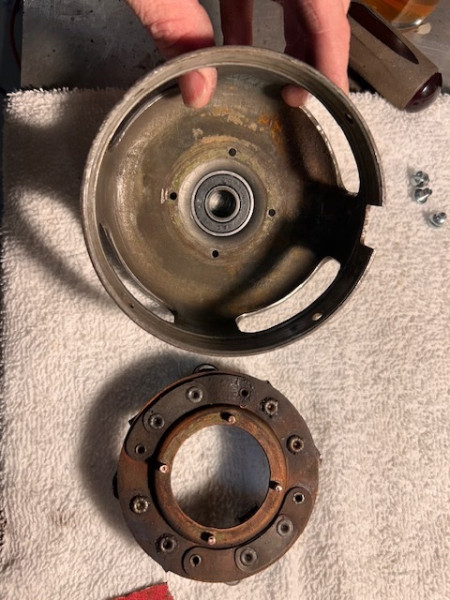
-
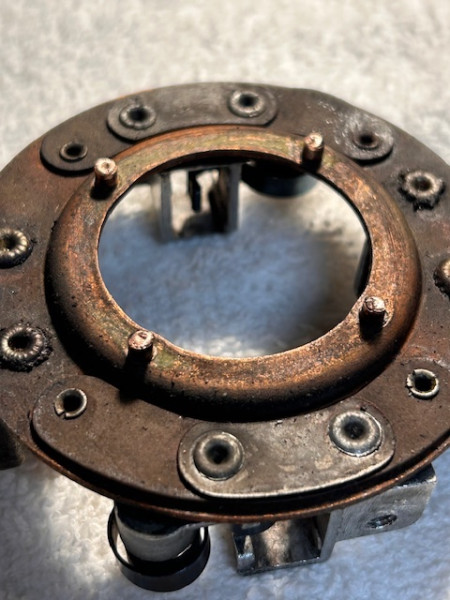
-
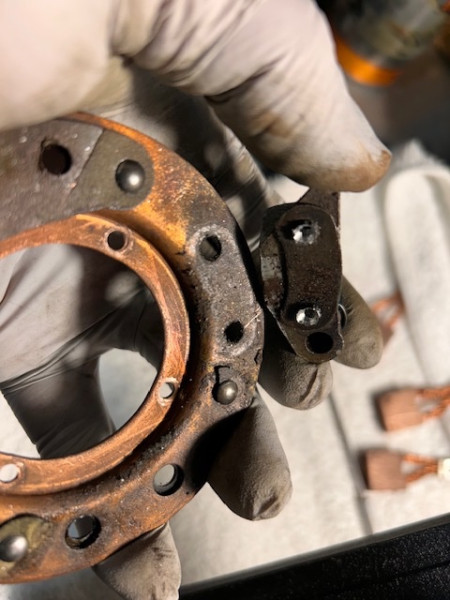
-
Topic author
vping
- Posts: 251
- Joined: Tue Sep 29, 2020 8:01 pm
- First Name: Vincent
- Last Name: Pina
- * REQUIRED* Type and Year of Model Ts owned: 1925 Tudor Sedan
- Location: Farmingdale
Post
by vping » Sat Feb 17, 2024 10:25 am
Last week went well-ish. I put everything back together and it cranked strongly a few times and then it was back to really slowly. I took it all apart again and double checked everything in case I missed something. I checked the starter components for continuity and functionality and all seemed well. Back in the car and it was much better. I did also have to add an additional ground strap from trans to cross member.
I am able to get the engine to pop off once with ether.
Today I'm going to check the grounds again and then work on fuel delivery.
I may look at taking the starter apart again and cleaning the brush plate.
Question, where can I get that bearing shown in your pic and is it plug and play or is there some modifications needed.
-
Topic author
vping
- Posts: 251
- Joined: Tue Sep 29, 2020 8:01 pm
- First Name: Vincent
- Last Name: Pina
- * REQUIRED* Type and Year of Model Ts owned: 1925 Tudor Sedan
- Location: Farmingdale
Post
by vping » Sat Feb 17, 2024 10:27 am
My brush plate actually looks fairly clean.
-
Attachments
-
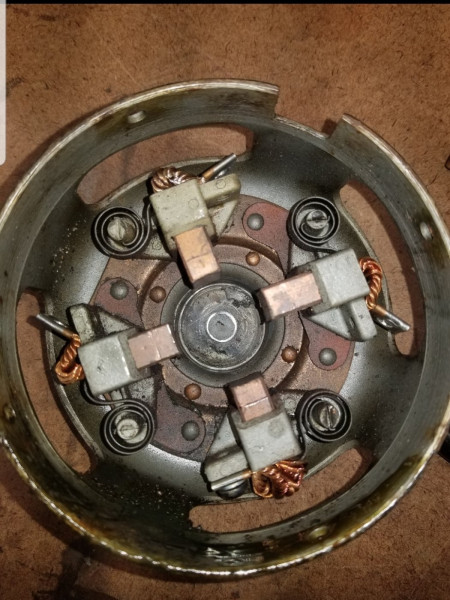
-
RajoRacer
- Posts: 5422
- Joined: Sun Jan 06, 2019 12:18 pm
- First Name: Steve
- Last Name: Tomaso
- * REQUIRED* Type and Year of Model Ts owned: 1914 Touring, 1919 Centerdoor, 1924 TT C-Cab Express, 1925 Racer
- Location: Longbranch, WA
- Board Member Since: 2001
Post
by RajoRacer » Sat Feb 17, 2024 10:40 am
Doesn't appear to be much left of that rear bushing !
-
speedytinc
- Posts: 5024
- Joined: Fri Feb 12, 2021 12:24 pm
- First Name: john
- Last Name: karvaly
- * REQUIRED* Type and Year of Model Ts owned: 14/15 wide track roadster. 23 touring, 27 roadster pickup, 20ish rajo touring
- Location: orange, ca
- Board Member Since: 2020
Post
by speedytinc » Sat Feb 17, 2024 10:59 am
Looks like there is no bushing.
Converting to a ball bearing requires machining the shaft down some.
-
jab35
- Posts: 1016
- Joined: Sun Jan 06, 2019 12:28 pm
- First Name: James
- Last Name: Bartsch
- * REQUIRED* Type and Year of Model Ts owned: '26 Coupe
- Location: Dryden, NY 13053
- MTFCA Life Member: YES
Post
by jab35 » Sat Feb 17, 2024 11:23 am
Vince: What if anything remains of the brush end bearing? Originally, they were Babbitt, but this modern ball bearing and spacer is a drop in replacement. Do NOT machine the armature shaft!
https://www.modeltford.com/item/5106RB.aspx
The only 'fitting' needed when I installed this bearing was some cleaning and polishing the inside of the end cap recess for the modern bearing. Mine was a snug slip fit, not a press fit, but the bearing needs to bottom out in the endcap. This is a fully lubricated sealed ball bearing that is fully seated in the end cap. The spacer goes on the shaft between the commutator and bearing to take up endplay. Good luck with your repair, jb
-
Ron Patterson
Post
by Ron Patterson » Sat Feb 17, 2024 12:08 pm
The problem with starter repair is that they usually have a combination of faults with the bushings, armature, brush cap, brushplate, field windings and Bendix drive. Some rebuilding steps require special tools.
As indicated above many faults occur on the side of the brushplate that is not visible. Suggest removing and completel;y rebuilding the brushplate too. Upon reinstallation use copper rivets and set with a pneumatic rivet setting tool and buck.
Unless you have the specialty tools required, don'try using a new bushing in the brush cap. Most parts suppliers sell a easy to install ball bearing replacement and spacer kit. Make sure it includes a 6201 2 RS 1/2 id ball bearing so you do not have to resize the armature shaft end.
Rebuilding starters is a slippery slope and EVERYTHING must be checked to get a properly working starter.
Ron Patterson
-
Topic author
vping
- Posts: 251
- Joined: Tue Sep 29, 2020 8:01 pm
- First Name: Vincent
- Last Name: Pina
- * REQUIRED* Type and Year of Model Ts owned: 1925 Tudor Sedan
- Location: Farmingdale
Post
by vping » Sat Feb 17, 2024 6:57 pm
Just so y'all know the bushing is stepped bronze.
-
Attachments
-
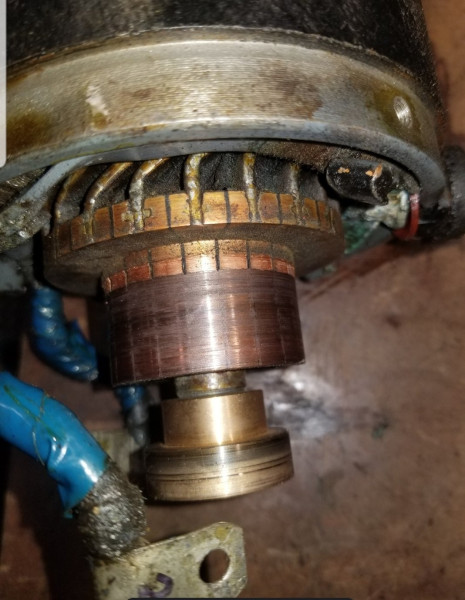
-
Topic author
vping
- Posts: 251
- Joined: Tue Sep 29, 2020 8:01 pm
- First Name: Vincent
- Last Name: Pina
- * REQUIRED* Type and Year of Model Ts owned: 1925 Tudor Sedan
- Location: Farmingdale
Post
by vping » Sat Feb 17, 2024 6:58 pm
-
RajoRacer
- Posts: 5422
- Joined: Sun Jan 06, 2019 12:18 pm
- First Name: Steve
- Last Name: Tomaso
- * REQUIRED* Type and Year of Model Ts owned: 1914 Touring, 1919 Centerdoor, 1924 TT C-Cab Express, 1925 Racer
- Location: Longbranch, WA
- Board Member Since: 2001
Post
by RajoRacer » Sat Feb 17, 2024 10:31 pm
The bushing should be in the brush holder - not stuck to the armature !
-
AdminJeff
Post
by AdminJeff » Sun Feb 18, 2024 3:24 am
With 37 replies to this thread, I've been loathe to add my 2 cents but now I can't resist.
Listen to Ron Patterson. His word is gospel when it comes to starters on a Model T.
I personally see a MAJOR problem with the commutator on your armature. Here's a closeup pic of what my finished and rehabbed commutators look like on a generator, and the starters are treated exactly the same, no different. They should look like this once rebuilt. This is ultimately where ALL the energy is delivered from the battery to turn the armature and it's a critical part of the rebuild. If you don't have a lathe and a way to cut the mica on your armature, youre better off having someone do it for you or just buy a rebuilt one. Your armature in its current condition is one of the worst I've seen, and like Ron, I've seen 100's. Bad armatures account for many problems on both starters and generators and one symptom is slow/erratic turning.
Ron is also spot on. there's a lot of specialized tooling and processes & techniques that go into doing this right. Get one thing wrong and it can have a cascading effect... and then you're not a happy T camper.
AdminJeff
-
Attachments
-
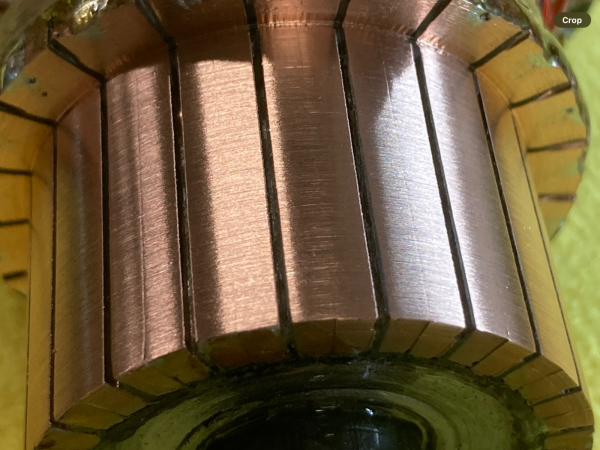
-
TXGOAT2
- Posts: 8158
- Joined: Sun Feb 14, 2021 10:08 pm
- First Name: Pat
- Last Name: McNallen
- * REQUIRED* Type and Year of Model Ts owned: 1926-7 roadster
- Location: Graham, Texas
- Board Member Since: 2021
Post
by TXGOAT2 » Sun Feb 18, 2024 10:50 am
Vp's armature has been turned several times, and all the commutator bars look to be shorted together by copper residue. I don't see much solder left where the windings attach to the commutator bars, either.
An armature in that condition will allow a lot of current to flow right past the windings to ground. The reduced diameter of the commutator can affect how well the brushes function and will reduce the brush spring pressure.
-
Ron Patterson
Post
by Ron Patterson » Sun Feb 18, 2024 10:58 am
I won't comment further on the points Jeff and Dave have made except to say they are exactly correct.
I would like to address the Brushcap Babbitt bushing problems depicted above which is one of the 7 or 8 discrete failures that must be addressed to rebuild (as opposed taking it apart and putting it back togather hoping it will work) a 100 year old Model T starter.
Fords selection of a Babbitt bushing in the brushcap was a cheap solution that was, in my opinion, not very well thought out though I doubt their horizon was for it to last a long time.
The main problem is during manufacture a dollop of something like Lubriplate was added to the bushing for lubrication and no easy provision to add more. That lube dried up and the bearing siezed to the armature shaft and started to spin inside the brushcap. You can see evidence of this in the photo above where the bushing has came out of the cap bore siezed to the armature end.
You will find many used starters with holes drilled into the brushcap for adding more bushing lubrication.
Babbitt is great for radial loads but Babbitt bushing and armature face were not set up for the axial force of the armature being pulled back and forth in the case during actual operation wearing the bushing face causing excessive armature end play. How many times have you seen excessive starter armaturer end play on a used Model T starter?
The Brass bushing sold by parts suppliers to correct this problem require some special tools to spot face the bushing to reset armature end play.
Another simple way to correct this problem requires no special tools, needs no lubrication and has no axial loading issues
Get a ball bearing bushing replacement kit form the parts suppliers consisting of a 6201 2 RS 1/2 ID bearing and spacer. The bearing is pre lubricated, has double lube shield, is well suited to the low duty cycle of the starting motor and will last another 100 years.
There are solutions like this described fix for each of the 7-8 discrete issues with worn our starters that are cumulative and ultimately cause starter failure.
If you dont adequately address each of them the first time you will be back at it again later. Good luck
Ron Patterson
-
Attachments
-
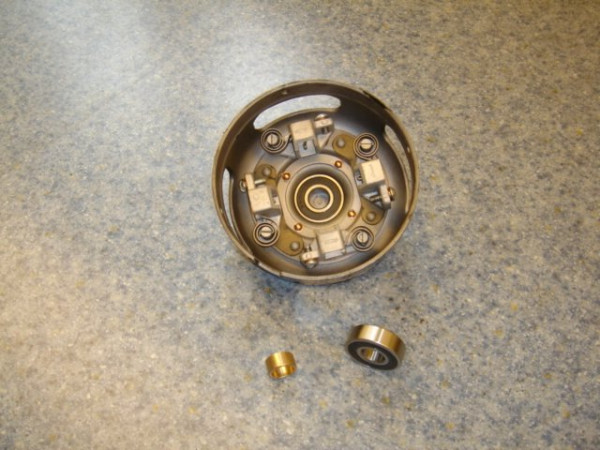
-
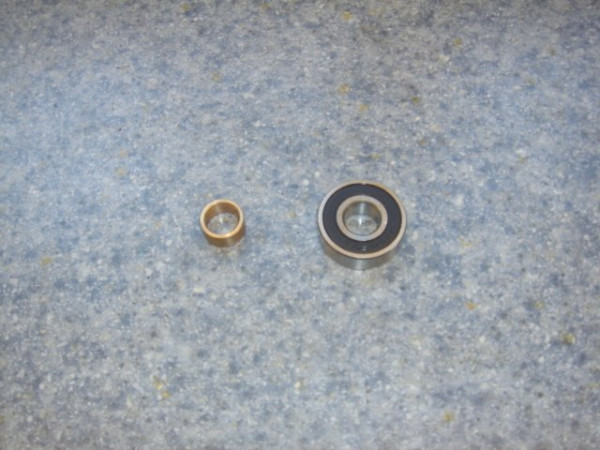
-
speedytinc
- Posts: 5024
- Joined: Fri Feb 12, 2021 12:24 pm
- First Name: john
- Last Name: karvaly
- * REQUIRED* Type and Year of Model Ts owned: 14/15 wide track roadster. 23 touring, 27 roadster pickup, 20ish rajo touring
- Location: orange, ca
- Board Member Since: 2020
Post
by speedytinc » Sun Feb 18, 2024 12:00 pm
Please excuse my ignorance for using the wrong ball bearing all these years & giving bad advice regarding its use. (6201 2 rs)
The bearing Ron suggests (6201 2 RS 1/2) with a spacer will make the conversion much simpler.
Secondly. Regarding cutting the mica on the commutator.
That is done on generators ONLY. Par. 920 in T1 service manual.
There is no such reference to the starter Par's 954 - 978
Further, having disassembled well over a hundred starters, there was no evidence of mica relief on untouched units.
Ron P. - feel free to weigh in here.
-
AdminJeff
Post
by AdminJeff » Sun Feb 18, 2024 12:21 pm
speedytinc wrote: ↑Sun Feb 18, 2024 12:00 pm
Secondly. Regarding cutting the mica on the commutator.
That is done on generators ONLY. Par. 920 in T1 service manual.
There is no such reference to the starter Par's 954 - 978
Further, having disassembled well over a hundred starters, there was no evidence of mica relief on untouched units.
Ron P. - feel free to weigh in here.
This is an interesting topic, for sure. The brushes on a T starter are hard, not soft like the gen. I should probably revise my comments to say more like "clean/scrape, then polish". I generally don't even turn it down on a lathe unless it's really bad. its probably 1/64" inch or less vs the deeper cuts on generators. Any more on a starter and it could create undesirable shorts. Perhaps its just me being meticulous. Regardless, that armature has seen better days.
These little hobby saws are perfect for the job.
-
Attachments
-
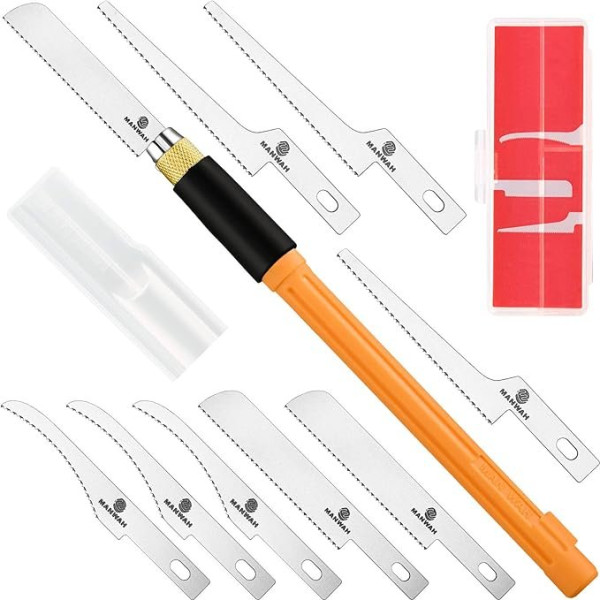
-
TXGOAT2
- Posts: 8158
- Joined: Sun Feb 14, 2021 10:08 pm
- First Name: Pat
- Last Name: McNallen
- * REQUIRED* Type and Year of Model Ts owned: 1926-7 roadster
- Location: Graham, Texas
- Board Member Since: 2021
Post
by TXGOAT2 » Sun Feb 18, 2024 12:32 pm
The commutator bars do need to be insulated one from another. The starter brushes have a higher copper content than the ones in the generator, and in normal, intermittent service will not bridge over the gaps between the commutator bars. When things start wearing out, longer duty cycles and higher loads due to bushing wear will act to increase current draw and overwork the commutator assembly leading to a condition like the one pictured above, where conductive copper residue has been smeared around the commutator, partially shorting the commutator bars to each other.
Batteries in poor condition cause more rapid starter wear and deterioration, as will junky cables and worn switches and engines that are difficult to start. Applying 12 volts to a stock 6 volt starter is not good practice.
-
Jerry VanOoteghem
- Posts: 4309
- Joined: Sun Jan 06, 2019 4:06 pm
- First Name: Jerry
- Last Name: Van
- Location: S.E. Michigan
Post
by Jerry VanOoteghem » Mon Feb 19, 2024 2:25 pm
TXGOAT2 wrote: ↑Sun Feb 18, 2024 10:50 am
Vp's armature has been turned several times, and all the commutator bars look to be shorted together by copper residue. I don't see much solder left where the windings attach to the commutator bars, either.
An armature in that condition will allow a lot of current to flow right past the windings to ground. The reduced diameter of the commutator can affect how well the brushes function and will reduce the brush spring pressure.
If you're saying that the OP's commutator has been turned way undersize when compared to Jeff's, it's because, (
I believe), Jeff has shown a generator commutator. I think starter commutators are smaller in diameter.
-
TXGOAT2
- Posts: 8158
- Joined: Sun Feb 14, 2021 10:08 pm
- First Name: Pat
- Last Name: McNallen
- * REQUIRED* Type and Year of Model Ts owned: 1926-7 roadster
- Location: Graham, Texas
- Board Member Since: 2021
Post
by TXGOAT2 » Mon Feb 19, 2024 8:10 pm
Could well be.